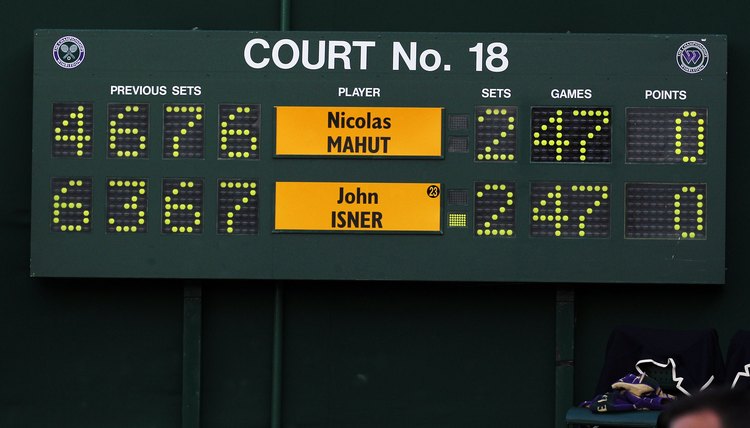How to Understand Tennis Scores

The point-scoring system in tennis is simple and straightforward, but the terminology is not. Once you understand what each term means -- for example, that the word “love” is equivalent to zero -- then you’ll have no trouble keeping the score of any tennis match.
Give the player who wins the first point a score of “15” within the first game. If a player wins two points within a game he receives a score of “30” and if he earns a third point his score rises to “40.” For example, if one player wins three of the first four points in a game he leads by a score of 40 to 15, rather than 3 to 1.
Award the player a victory in a game if she scores four points, provided she leads by at least two points. For example, if a player leads 40 to 15 and earns the next point, then she wins the game. But if her opponent scores two consecutive points to tie the score at 40 to 40, the game continues until one player earns a two-point lead.
Declare the game to be at “deuce” if the score is tied at 40 to 40. The player who wins the next point is then declared to have the “advantage.” If the player with the advantage wins the following point, he wins the game. If the opponent wins the next point, the game returns to deuce. Play continues until the player with the advantage wins the next point.
Award the player who wins the initial game a 1 to 0 lead in games within the first set. Competitive tennis is typically played as a best two-out-of-three-set match -- meaning the first player who wins two sets wins the match, though some matches are played as the best three out of five sets.
Continue counting the number of games each player wins within the set. The first player to win six games wins the set, provided she wins by a margin of two games. If the score is tied at 5 to 5, the competitors play two more games. If one player wins both games, she wins the set by a score of 7 to 5. If each player wins one game, the set typically goes to a tiebreaker.
Score the tiebreaker one point at a time. The first player to win a point is said to lead 1 to 0, rather than 15 to love. The first player to score seven points, with a victory margin of at least two points, wins the tiebreaker and the set. If the tiebreaker is tied at 6 to 6 it continues until one player leads by two points.
Award the player who wins the first set a 1 to 0 lead in sets. The first player to win two sets in a three-set match -- or three sets in a five-set match -- is declared the match winner. You do not require a two-set victory margin to win the match.
Tips
Some tournaments don’t use the tiebreaker system. In those cases if a set is tied at 6 to 6, play continues until one player owns a two-game lead.
References
Writer Bio
M.L. Rose has worked as a print and online journalist for more than 20 years. He has contributed to a variety of national and local publications, specializing in sports writing. Rose holds a B.A. in communications.
